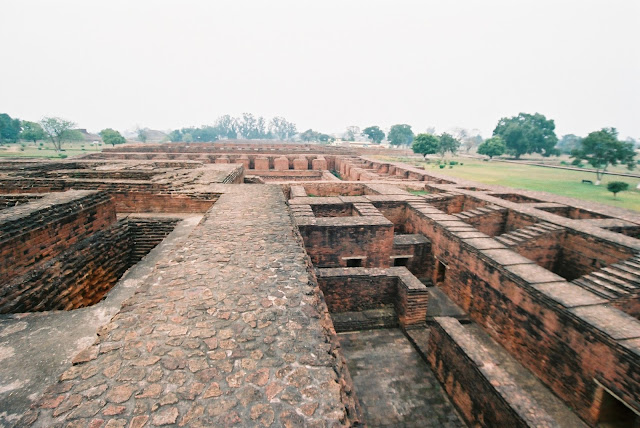India Chronicles: Nalanda – the universe of knowledge
 |
| Odantapuribs - Own work, CC BY-SA 4.0: Temple No.- 3 at Archaeological Site of Nalanda Mahavihara |
This is perhaps one of the oldest hubs of learning and knowledge known to mankind – with the distinction of being “one of the first great universities in recorded history” and a UNESCO World Heritage Site.
Nalanda University, an hour’s drive from Patna, the capital of Bihar, according to historical accounts, was a centre of learning where scholars from far and wide came to enhance their knowledge. The long and illustrious life of the university lasted for 800 years – from the fifth to the 12th century CE. It is said that in the seventh century CE, the university accommodated more than 10,000 students and had 2,000 teachers.
The university was considered an architectural marvel and had eight separate compounds with many classrooms. Built from red bricks, the university compound also had numerous lakes and parks. In the seventh century CE, Chinese monk Xuanzang gave a first-hand account of his experience at the university: “An azure pool winds around the monasteries, adorned with the full-blown cups of the blue lotus; the dazzling red flowers of the lovely kanaka hang here and there, and outside, groves of mango trees offer the inhabitants their dense and protective shade.”
The university campus was in harmony with man and nature and provided a congenial environment for learning. This may be the reason that a visit to Nalanda, for many, is akin to a pilgrimage.
“The legacy of the ancient Nalanda University does not belong to any one country or people,” said Prathit Misra, second secretary, High Commission of India to Jamaica. “Its strength lay in being able to integrate the ideas and philosophies from different regions of the world and give them equal respect and consideration.”
SUITE OF COURSES
 |
| Oo91 - Own work, CC BY-SA 4.0 |
Nalanda University offered a suite of courses – from science, astronomy, medicine to metaphysics, philosophy, and the scriptures of Buddhism and Hinduism.
Also in the curriculum was the study of foreign philosophy. The university’s popularity spread beyond the shores of India. Students and scholars from Korea, Japan, China, Indonesia, Sri Lanka, Persia, Greece, and Turkey travelled to Nalanda to acquire an education.
“The mission of this university was to spread the light of knowledge and learning to the farthest corners of the world and also to remain open and receptive to the new teachings that other institutions had to offer,” Misra said.
The university campus was ravaged, set on fire, and razed to the ground in 1193 by Turkic (referred to collection of ethnic groups of Central, East, North and West Asia as well as parts of Europe and North Africa) invaders.
With the destruction of Nalanda, hundreds of thousands of volumes in its three famous nine-storey libraries, where meticulous copies of texts were produced, were also lost. The fires are said to have burnt for three months.
This preceded the decline in the popularity of the university as the geopolitical situation in India changed, with Buddhism ideologies waning. Nalanda was eventually abandoned and lost in time until the 19th century, when the site was surveyed, and excavations were conducted by the Archaeological Survey of India.
Systematic excavations, begun only in 1915, unearthed a trove of sculptures, coins, seals, and inscriptions.
Recent archaeological discoveries reveal that Nalanda dates back to 1200 BCE, although the university was established later.
LINKS WITH JAMAICA
 |
| Hideyuki KAMON: Excavated ruins of the monasteries of Nalanda. |
Nalanda may not be a name that would have been popularly known in this part of the world, and certainly, in the grand scheme of things, would not come to mind when mentioning India. But Jamaica and the wider Caribbean have deep-rooted links with that part of India.
It is from the eastern Indian state of Bihar and adjoining regions that most of the Indian indentured labourers were brought to the Caribbean. This year also marks the 175th anniversary of the arrival of Indians to Jamaica. More on that for another day.
“Being related to eastern India historically,” said Misra, “Jamaicans are also the proud carriers of the legacy of the great Nalanda University in the spirit of ‘Out of Many, One People’.”
Centuries later, the messages that resonated from Nalanda are still relevant. The cosmopolitan spirit and openness of this university is needed today to advance the cause of a barrier-free flow of knowledge and learning, democracy, and global cooperation.
The splendour of Nalanda University permeates from the remnants of the campus, which stood in its glory and grandeur. A walk down the cobbled brick paved paths of this once-grandiose centre of knowledge enlightens and uplifts the spirit. Still resonating from the intricately carved remains of the structures are the chants of the students and the flow of pious energies – touching all the senses – calming the mind, body, and soul.
For somewhere, even in far distant memories, and buried in the ruins, Nalanda exists.



Comments
Post a Comment